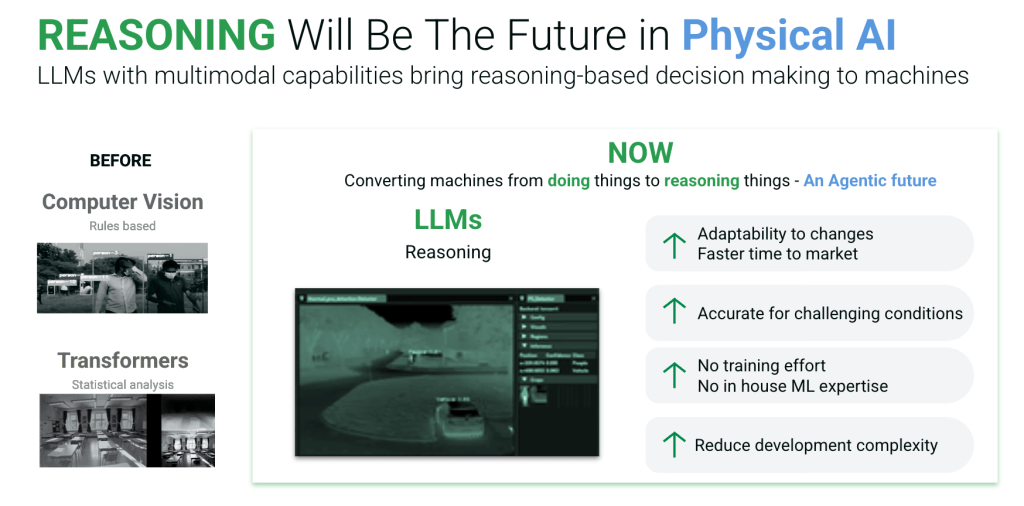The Era of Physical AI is Here
The AI landscape is undergoing a monumental shift. After a decade where AI flourished in the cloud, scaled by hyperscalers, we are now entering the era of Physical AI. Physical AI is poised to touch every facet of our lives. Imagine industrial processes with unprecedented precision, diagnostic tools in medicine and machinery that offer deeper, more accurate insights, and robotic and automotive platforms transformed by intelligent, agentic AI.
This isn’t just about AI becoming more prevalent; it’s about a fundamental transition in machines merely doing things to actively reasoning things. This profound change is being propelled by the widespread deployment of open source LLM/GenAI (reasoning) AI models and increasingly very capable models at 1, 3, and 8B parameter sizes. The last missing piece has been the right silicon and software to run LLM applications at < 10W on device, and now with the announcements from SiMa.ai today, we complete the picture. The era of Physical AI is here.
SiMai.ai today is making three significant product announcements to accelerate the scaling of Physical AI:
- Production and immediate availability of its next-generation Physical AI silicon, MLSoC Modalix™.
- Immediate availability of System-on-Module (SoM) and devkit to accelerate production. The SoM is also form factor and pin compatible with leading GPU vendor SoM.
- Debut of LLiMa™, a software framework built to deploy high-performance LLM and GenAI models on Modalix, seamlessly, for Physical AI applications.
Beyond the Edge: Defining Physical AI
It was a “rule based compute” world with CPUs, SoCs, DSPs, and GPUs running compute for systems for over 40 years. Edge AI helped spur AI adoption forward and brought forward a “statistically inferred compute” world. While Edge AI brought AI capabilities closer to the source of data, Physical AI takes this a significant leap further, closer to mimicking human capacity. Physical AI does a better job by adopting a “reasoning based compute” that better reflects the interactions and decision making process of how humans reason and interact. Large Language Models (LLMs) with multimodal capabilities are emerging as a cornerstone of Physical AI. LLMs enable machines to directly interact with and influence the physical world, making real-time decisions based on complex, multimodal data. Additionally, LLMs offer several key advantages:
- Adaptability to Change: LLMs can reason and adapt to new, unforeseen conditions.
- New possibilities: A rich open source environment enables quicker innovation.
- Accuracy in Challenging Conditions: They can perform robustly even in complex environments with higher accuracy, more context, memory and more relevance.
- Reduced Development Complexity: With LLMs, there’s less need for extensive training efforts or in-house ML expertise for every new task or application.
Building the Next-Gen Infrastructure for Physical AI
It is our strong belief that 75% of all physical systems we interact with will be impacted by Physical AI, including, Automotive, Robotics, Manufacturing, Medical, Vision systems. However, this transition from Edge to Physical AI comes with substantial challenges, including:
- Power Consumption: Running sophisticated AI models in physical environments demands highly efficient power solutions.
- Software Flexibility: The need for adaptable software to handle diverse real-world scenarios and also ensure that systems keep up with the speed of AI innovation.
- Full Multimodal Capabilities: Processing and interpreting multiple forms of data input (visual, audio, LIDAR, etc.) and generating appropriate outputs, all with real-time latency.

The Physical AI era will be dominated by multiple, hybrid ML architectures. Further adding to this architectural complexity is the dynamic AI model landscape that shifts every 9-12 months. SiMa.ai developed our three pronged approach–Modalix, SOM, and LLiMa–to ensure that customers have the LLM silicon platform required to meet this complex computational challenge.
Why SiMa.ai is Uniquely Positioned for Physical AI
We are focused on providing the widest support of AI innovation in CNN, Transformer, LLM, and GenAI-centric applications with ease of use in development, deployment, and best in class performance per watt – which are critical for Physical AI. While some competitors have compelling stories in the AI space, their solutions often come with high costs and power requirements that are not well-suited to production scale physical AI. Legacy silicon architecture and software limitations present huge challenges in enabling performance and power efficient implementations of LLMs in physical AI. Many private AI accelerator companies will require an external host and a multi-chip solution to solve for Physical AI, along with having to address performance, power, and accuracy needs , while providing a robust toolchain to enable wide support for ever evolving LLMs.
SiMa.ai is all in on Physical AI! We have spent years serving these end markets and have understood our customer needs for a software-centric approach to Physical AI better than anybody else. Our silicon and software is purpose-built to meet the needs of customers scaling Physical AI. We are the only company that delivers on <10W power consumption for a wide suite of cutting edge complex LLMs suited for Physical AI and in a compelling SoM or PCIe form factor. Our Modalix platform delivers LLMs with the complexity and capability of the knowledge of the internet in the palm of your hand – with no web connectivity needed!
We are well positioned to lead Physical AI in this transformative era and we are excited to partner with customers globally to scale Physical AI in their applications.
